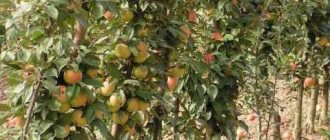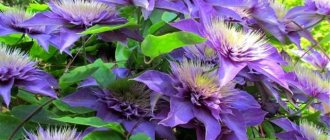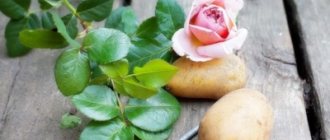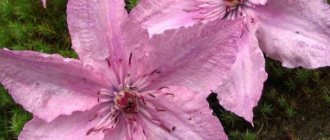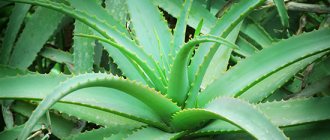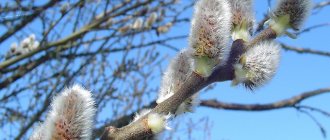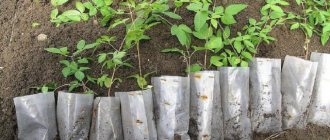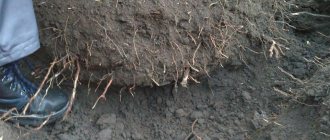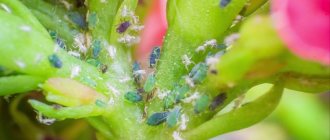Clematis - planting and care in open ground for beginners
To properly care for your planting, you need to know the basic characteristics of the plant.
Requirements for planting material
The main requirements for planting material depend on the time of year:
- When planting in autumn, the plants should have well-developed vegetative buds.
- In spring, the plant must have at least one shoot.
- Seedlings are used that have three roots over ten centimeters in length.
Clematis - a luxurious garden decoration
If the flower has a weak root system, it must first be germinated. To do this, it is placed in a special container.
Important! Before planting clematis, you need to make sure that the planting material is completely healthy. Only elastic roots are suitable, without damage, swelling or discoloration.
Clematis seedlings
How to preserve a seedling before planting
A plant seedling can be purchased in advance before planting. The flower can grow for a certain time in an apartment, but the basic rules of care must be followed:
- Clematis is placed in the brightest place.
- It is necessary to regularly check its neck and, if necessary, add soil.
- In order for the roots to develop better and additional shoots to appear, the tops are pinched.
- It is important to avoid overwatering, as this will cause the development of fungal diseases.
- The plant needs hardening. If it's a warm sunny day, you can keep it with the window open.
- If necessary, clematis shoots are tied to a support.
- The plant can be fed with fertilizers intended for indoor flowers.
Following these rules before planting clematis will help you grow a strong plant. It will easily take root in the garden in the future.
Preservation of seedlings at home
Clematis roots
The flowering of a plant, its beauty and health depend on the condition of the root system. Most varieties have succulent roots. It is important to take care of their intensive development. The roots love shade, although the plant itself grows well in the sun. In this regard, it is recommended to plant low-growing shrubs next to the flower.
Important! High humidity in the soil should not be allowed, as this provokes the proliferation of pathogenic fungi.
Botanical description
The types of clematis are very different from each other. Among them there are subshrubs, shrubs, and herbaceous perennial plants, but most of the species belong to the group of lianas. Their root system is of two types: taproot (plants of this group are difficult to transplant) and fibrous. The shoots of the current year in clematis are thin, in herbaceous species these shoots are green and rounded, in woody species they are faceted. Such shoots develop from above-ground buds of old shoots or from the underground part of clematis. Clematis leaves are simple or compound (consisting of three, five or seven leaflets), paired, usually green, but in some species they are purple.
- Tree care in spring
Bisexual clematis flowers are single or collected in inflorescences of different shapes (semi-umbrella, shield, panicle). There are different numbers of petals (actually sepals): from four to eight, and in double forms - up to seventy. In simple forms, in the center of the flower there are many stamens and pistils, which makes the middle look like a hairy spider, often having a contrasting color.
In general, the color range of clematis is very wide: from pale pink to dark red, from light blue to velvet blue and, of course, there are clematis in white and yellow shades. Each flower lives for two to three weeks; many varieties of clematis exude an aroma reminiscent of primrose, jasmine or almond. The fruits of clematis are numerous achenes.
When is the best time to plant clematis?
Roses - planting and care in open ground for beginners
It is important to observe the correct time for planting a flower. The plant belongs to the crop with early vegetation. If you do not plant it in a timely manner, the biological rhythm will be disrupted. This will lead to the fact that the flower will not have time to take root before the cold weather.
The timing of planting depends on the region:
- If the procedure is carried out in the spring, it should be done before the buds swell and open. For the central part of Russia, this time begins in mid-April and lasts until early May.
- Clematis that were grown in an apartment are not recommended to be transplanted into open ground until the frosts have passed. A change in temperature will be detrimental to the plant.
- If planting occurs in autumn, it should take place no later than the end of August. This will help the plant take root before frost sets in.
Disembarkation rules
In summer you can plant clematis with a closed root system. To do this, choose a cloudy day. For the winter, the plant is transferred to a greenhouse or apartment, where it grows until it can be transplanted into open ground.
Important! If you purchase a rooted cutting in a store, packaged in a bag with a peat mixture, it cannot be planted in open ground. In the first year, it can only be grown in a deep container, kept warm for the winter. Only the next year the seedlings are moved into open ground to a permanent place.
Features of planting clematis in the autumn season
Gardeners consider autumn the most suitable time for planting clematis. The plant manages to strengthen the root system before the beginning of winter. The most optimal soil and air temperature for planting is observed in September.
Despite the fact that many varieties of flowers have been bred that tolerate frost well, the autumn plant requires special care. To prepare it for wintering, you will need to carry out a number of activities:
- Young seedlings must be covered for the winter. This can be done with dry leaves, branches or improvised material, for example, film, roofing felt.
- No later than October, the bushes are fed with a mixture of humus and ash.
- In autumn, stop watering the plant. It is important to follow this rule, since during night frosts the moisture will destroy the roots.
- Bushes that are already one year old are completely freed from dry foliage and trimmed. Only the trunk, up to 30 centimeters long, remains.
- After pruning, clematis is spudded, then covered with branches and film.
Important! If the plant has long shoots, it is rolled up, wrapped in material, laid on the ground and covered with roofing felt. This will protect the roots from moisture.
Features of planting clematis in spring
Most varieties of clematis are recommended to be planted only in spring. The vine needs time to properly take root and prepare for winter. A perennial plant planted in the spring will develop a good root system before frost, allowing it to grow for at least twenty years.
Spring planting has its downsides. It is important to meet the deadlines, since the bush begins its growing season very early. If you plant a plant with bare roots and budding buds, it will react strongly to the slightest damage. Therefore, it is important to have time to plant it before the buds open.
How to grow clematis from seeds
Propagation by seeds is the best way to create a new hybrid. This is a long process. There are three groups of clematis with different seed sizes and germination times:
- large seeds germinate in 2 to 8 months;
- for medium-sized seeds, the germination rate ranges from 2 to 6 months;
- For small seeds, the germination rate is shorter - ½ - 4 months.
It is better to use fresh seeds, but those saved from previous years are suitable. They are stored in paper bags at a temperature of 18-23°C. Small grains are sown in March or April, medium grains in winter, and large grains in autumn or early winter.
First, the seeds are soaked in water for 10 days, but the water is changed 4-5 times daily. Then they are sown in containers with soil consisting of equal amounts of earth, humus and sand. A ready-made soil mixture for flowering plants is suitable. Spread the seeds loosely in a moistened substrate and lightly sprinkle with sand. The container is covered with glass or wrapped in cellophane and ventilated periodically. Optimal temperature conditions are 25-26°C. Moisten the soil mixture.
After the first shoots appear, the containers with seedlings are moved to a lighted place, possibly on the windowsills of eastern windows. Seedlings dive into separate pots when they grow 2-3 true leaves.
For growing, strengthened seedlings are planted in open ground in a shaded place every 15-20 cm. It is recommended to periodically pinch to strengthen the roots and increase the branching of the plant. In the fall, the seedlings are insulated, and in the spring they are again transplanted into prepared trenches. The root collar of the seedling is deepened by 5-7 cm. The distance between them is 0.5 m. Full-fledged seedlings are obtained in 2-3 years. Then they are planted in a permanent place.
Step-by-step instructions for spring planting clematis
Garden hydrangea - planting and care in open ground for beginners
Knowing the sequence of how to plant clematis correctly will help you grow a gorgeous plant in your dacha.
Soil and planting rules
Soil preparation should be carried out in advance. This is necessary for the earth to settle. It is best to hold the event within 1.5 months.
What kind of soil does clematis like?
The plant prefers nutritious and loose soil, which quickly absorbs excess moisture. You cannot plant a flower in soil with high acidity. This will lead to his death.
It is important to check the humidity level when choosing a planting site. The plant does not tolerate abundant groundwater. Experienced gardeners recommend preparing artificial mounds for comfortable growth of clematis. To remove moisture, grooves are made and filled with sand.
Preparing the planting hole
Before planting the plant, the area is cleared, debris, stones, and weeds are removed. If the soil is acidic, it needs to be neutralized. To do this, the area is dug up and wood ash is added to the ground at the rate of 200 g per square meter.
Pit preparation
Stages of preparing the planting pit:
- It is necessary to dig a hole 60 centimeters deep.
- Place a drainage layer of 15 cm at the bottom. This can be expanded clay, gravel, pebbles.
- Fill the hole two-thirds with a mixture of river sand, peat, humus and turf soil. You can add 150 g of mineral fertilizer.
- Then water the soil thoroughly to allow the soil and fertilizer to settle.
Important! It is best to leave a distance of one meter between bushes. If a gardener wants to organize a dense flower bed, you can plant clematis at a distance of 30 cm from each other.
Choosing a location and preparing for planting clematis in open ground
When choosing a location, you need to take into account that the plant does not tolerate high humidity. It is necessary to avoid wetlands, stagnant water, and runoff from roofs. This leads to the development of fungal diseases in the plant.
The area under the tree is not suitable for clematis. Both the bush and the tree have large roots; they will begin to pull nutrients from the soil from each other.
Clematis flowers grow well in full sun, but the roots prefer shade. In this regard, it is best to plant ornamental grass nearby.
Clematis planting technology
The process of reproduction and the timing of planting clematis can be traced according to the following diagram:
- The pit with fertilizers is compacted.
- If a seedling with an open root system is used, then a mound is made in the center. The plant is placed on it, the roots are straightened in a circle.
- Seedlings with a closed root system are placed in the center of the hole.
- The root collar is covered with 10-15 centimeters of soil. Several buds should be hidden by the soil.
- A small groove is made around the trunk for easy watering.
- After planting, water the bush well, place a peg next to the hole, to which the seedling is tied.
- Mulch with peat or sawdust.
After planting, arcs are installed around the plant, then you need to cover the plant for several weeks with agrofibre.
Clematis planting technology
In spring and summer?
Depending on the type of soil on your site, the optimal time for replanting and dividing clematis may be either spring or late summer. If you are the owner of a garden on light loam or sand, you should get down to business early - in the spring. On heavy and medium loams, as well as in places where the ground takes a very long time to warm up at the beginning of the season, it is better to postpone planting until August.
The best time for spring replanting and dividing clematis can be considered the period from the moment the soil completely thaws until the young shoots of the plant reach 10–15 cm in length. You simply won't be able to keep longer green stems alive in the hot spring sun. Naturally, these will be different dates in different regions of our country. In central Russia, depending on the weather, they focus on mid-April - early May.
Article on the topic
Buyers of seedlings. We inspect the plant from roots to crown
Clematis: general rules for care and cultivation
Caring for clematis does not require much effort. The plant needs it only in the first year after planting.
Caring for clematis in the first year
Irises - planting and care in open ground
After planting, the flower is under stress and needs help getting used to the soil. It is important to provide shade until it gets established. To do this, arcs are installed on the sunny side and agrofibre is stretched.
There are a number of recommendations on how to care for clematis in the first year:
- After planting the plant in open ground, you need to carefully monitor the level of soil moisture. Overwatering should not be allowed, but drying out is also dangerous for the flower. Water it once every seven days. If the weather is very hot, the procedure is increased up to two times.
- The area around the plant should be mulched regularly. This will help retain moisture in the soil and protect the roots from overheating on hot days.
- Experienced gardeners recommend planting marigolds next to the bush. They are able to protect clematis from pests.
- After each watering, the soil around the plant must be loosened. This will open up oxygen access to the root system and improve the soil structure.
- It is important to remove weeds immediately.
- In the first year, the plant in open ground needs to be pruned. This is done in the fall, all shoots are cut off, leaving only 30 cm above the surface.
Important! In order for the flower to winter properly, it is important to take care of its shelter. This is done just before frost. Shelter is especially important in the Moscow region, in the Urals, in the Leningrad region, and in Siberia.
How does clematis grow?
The plant is creeping up. It is due to this method of growth that it attracts gardeners. Use clematis to create stunning arches in your garden. For proper growth, the flower needs support. Both chain-link mesh and posts with tensioned wire are suitable for this.
Support for clematis
You can choose several types of flower supports:
- arches;
- pyramids;
- cylinders.
Thanks to such supports, you can create beautiful structures and support the stems. It is important that the material is durable and can withstand a heavy plant.
Diseases and pests of clematis
Most often, clematis is affected by fungal diseases:
- Wilting is caused by two types of fungi - the genus Phomopsis and Fusarium. Not only leaves are affected, but also stems and shoots. Damaged parts must be removed and burned. Treated with fungicide. In case of severe damage, the bush is dug up and burned.
- Gray rot appears as brown spots on shoots and leaves. Appears during rainy seasons. Treatment: spraying and watering with foundationazole.
- Powdery mildew is identified by a white coating covering leaves, flowers, and shoots. For prevention purposes, spraying with a solution is carried out in the spring. To prepare it, take 30 g of copper sulfate, 300 g of soap, dissolve in 10 liters of water.
- Rust affects leaves and shoots. Once signs are detected, damaged areas are removed. Use 2% Bordeaux mixture for spraying.
Clematis rarely suffer from viral diseases. Sometimes insects bring in a yellow mosaic of leaves. There is no effect from the treatment. The plant is destroyed. It is not recommended to grow delphiniums, peonies, phlox, aquilegia, hostas, and peas near them.
Damage by leaf and root-knot nematodes is not often observed. The plant withers and becomes deformed. Thickenings appear on the roots. Pests are introduced from weeds or from the soil. For prevention, dill, parsley, marigolds, calendula, and coriander are planted nearby. Affected plants are removed.
In addition to nematodes, there are pests:
- fenestrated moth - a butterfly that breeds caterpillars that feed on clematis leaves;
- beet aphid , covering the lower part of the leaves;
- spider mite;
- slugs and snails.
To combat them, insecticides and folk remedies are used.
For clematis, abundant feeding, timely watering, proper planting and pruning are important. Following these recommendations will allow you to grow beautiful flowering plants.
marked
Your opinion is very important to us. Please rate the article: 10 , rating: 4.00 out of 5
See also related articles
Calendula: care and cultivation in open ground
Dahlias: growing and care in the garden
Pansies: care and cultivation in a flowerbed
Aquilegia: growing from seeds at home
Iberis: growing from seeds, when to plant
How to grow ginger at home: from a root bought in a store
Heliotrope marin: growing from seeds
Miscanthus: planting and care in open ground
Garden buttercup: planting and care in open ground
Tulips: care and cultivation in the garden
Azarina climbing: growing from seeds
Garden callas: planting and care
Add a comment Cancel reply
You must be logged in to post a comment.
✿ Alphabetical index
✿ Categories
- Houseplants
- Bromeliads
- Decorative foliage
- Trees and shrubs
- Orchids
- Succulents
- Blooming
- Perennial
✿ Popular articles
- How to grow chestnut from a nut at home in a pot
- Clematis: care and cultivation in the garden
- How to grow pomegranate from seeds at home to produce fruits
- How to grow lemon from a seed at home with fruits: step by step
- Decembrist flower: care at home, how to water correctly
- Hedera "Helix mix": home care
✿ Latest comments
- Lyudmila on How to grow a lemon from a seed at home with fruits: step by step
- Tatyana on Tillandsia Anita: care at home
- LOVE for the entry Tulips: care and cultivation in the garden
Copyright © 2018-2021 GARDENER'S BOOK.
0+ By using bookgardener.ru you accept the terms of the USER AGREEMENT. Copyright for the posted materials belongs to the editors of the online magazine. When reprinting and using materials, an active hyperlink to BookGardener.ru is required
How to properly care for clematis
In order for the plant to be lush and have a beautiful shape, subsequent care of clematis must be timely. It is important to pinch and tie it correctly.
Features of watering
Over-watering is harmful to the flower. In this regard, you should not water it too often, the only exception being dry and hot weather. The procedure is required once a week in the first year of the plant’s life.
From the second year, the bush is watered once every ten days. To check if the plant has enough water, you can dig the soil. If it is dry by 25 cm, this indicates a lack of moisture.
Fertilizer application scheme
One of the important conditions for proper bush care is soil aeration. It needs to be loosened after each watering. This activity can be replaced by mulching with old manure.
Very important! Do not use fresh manure!
The flower needs fertilizer. The need increases with plant growth. Feeding should be done every two months. The amount of fertilizer depends on the size of the plant. A large adult bush will require a bucket of solution.
In the process of feeding the plant, you need to alternate organic and mineral complexes. Organics are used only in diluted form. To feed the roots, you can use urea diluted in a ratio of 3 liters of product per liter of water. In winter, only wood ash is used.
Nutrient deficiencies can be detected by the following signs:
- The shoots are shortened, new leaves appear in very small sizes. The color becomes less vibrant. This indicates a lack of nitrogen fertilizers. They are introduced in the spring during the growing season.
- The leaves acquire a purple tint. The plant becomes weak and cannot easily tolerate frosts. The problem can be eliminated with the help of phosphorus fertilizers.
- If a plant's leaves and buds turn black, it is lacking potassium. In such a situation, fertilizing with potassium nitrate in spring and summer is required.
Over the summer, clematis is able to produce a large number of shoots and leaves. Therefore, in the first year, additional nutrition for the bush is very important. You need to feed the flower twice a month, using liquid fertilizers.
The first feeding should be carried out in the spring when shoots appear. It is best to use ammonium nitrate at the rate of 1 tablespoon per 10 liters of water.
Fertilizing clematis
What do clematis like for lush flowering: tricks of experienced gardeners
For active flowering, many gardeners use growth activation products. In addition, it is important to open the insulation in time after wintering. This must be done as soon as the snow cover melts. If you miss time, the shoots will intertwine with each other and break when the plant opens.
How to care for a crop after flowering
After mass flowering has passed, you need to carry out a comprehensive fertilization procedure. Do not fertilize during flowering, as this reduces flowering time.
Clematis pruning
You can prune clematis during the period of active growth, as needed, to prolong flowering, and even before winter. It was already mentioned above that clematis are divided into 3 groups:
- Group A (first group) . Flowers appear on the previous year's stems; therefore, only weak shoots need to be pruned. Pruning is done in June, when the plant has finished flowering. In late autumn, the bushes need to be hilled high.
- Group B (second group) . Flowers are formed on the shoots of this and last year. The shoots need to be shortened to 50–100 cm, leaving 2–5 pairs of buds. Weak stems must be cut down to the base. For the winter, you need to remove such a plant from its support, roll it up and carefully place it at the roots.
- Group C (third group) . Flowers appear only on young shoots this year. This vine is pruned several times during the growing season. In autumn, all stems should be cut to the level of the surface of the site or slightly higher.
PRUNING CLEMATIS. Highlights and TIPS. What is IMPORTANT to know!
Clematis diseases and their treatment
The most dangerous pathology for clematis is wilting. This is a pathology that manifests itself in the drying out of branches. If a plant gets sick during the growing season, this leads to its death. To prevent the problem, it is necessary to ensure proper nutrition of the roots.
Flower diseases also include:
- Spotting is the formation of fungi carried by snails. Brown spots appear on the leaves, causing necrosis. The leaves begin to fall off. Treatment is carried out using copper sulfate.
- Powdery mildew is a pathology that affects the ground part. Growth and flowering stop, the branches become covered with plaque, and the plant gradually dies. Salicylic acid is used for treatment.
Among the pests that clematis are afraid of are nematodes, spider mites and scale insects.
Plant diseases
Why doesn't clematis bloom?
Lack of flowering can occur for various reasons. This may happen if:
- the bush is planted in the wrong place;
- soil is too wet;
- a diseased seedling was used;
- there are not enough nutrients in the soil;
- There are a lot of weeds around the bush;
- The rules were broken during circumcision.
The lack of flowering can be caused by several reasons.
Important! In the first year the plant does not bloom.
Clematis planting - how to prepare a seedling
Before planting a seedling in a completely new and unfamiliar environment, in which it will still have to get used to, it is necessary to thoroughly prepare it. However, this procedure applies specifically to the cutting itself. It is not necessary to renew the soil in the storage container.
In order to properly and competently prepare, you must perform the following steps:
- The day before planting, it is necessary to soak all the roots of the plant in a solution that stimulates growth and development. How to properly dilute it will be written on the package with the active substance, so follow the instructions carefully.
- If, suddenly, mold or rot appears on the spine, then the damaged areas must be removed until only healthy tissue remains.
- After this, you need to resort to some kind of fungicide that will help the plant not become infected through exposed tissue. If the roots have grown too long, they should be cut off. Usually a third of this length is enough.
- Small leaves could appear above the root collar while the plant was gaining strength before planting. We will definitely need to get rid of them, since we will have to bury the petiole, and the leaves will greatly interfere with this.
Clematis: preparing for winter
Preparing the plant for wintering begins in August. It is important to carry out all activities in a timely manner so that the plant has time to prepare for the upcoming cold weather. How does clematis overwinter?
The main measures to prepare for winter are:
- In August, fertilizing with nitrogen fertilizer stops.
- In September, the plant is strengthened with phosphorus-potassium fertilizers. They help shoots emerge faster and prepare for winter.
Pruning clematis before winter
A month before the onset of frost, the plant is pruned. Clematis that bloom on this year's shoots should be fully pruned in the fall. Plants of the second year are not completely pruned; their shoots and buds are preserved.
How to cover clematis for the winter
Caring for clematis in winter involves sheltering not only from frost, but also from moisture. Therefore, the material must be dry. It is designed to protect roots and shoots from precipitation, melt water, and icing.
It is important to strictly adhere to the terms of shelter. You need to focus on the air temperature. You need to cover clematis as soon as the air drops to -5 degrees. Most often this period falls in November. The procedure is carried out only in dry weather.
The plant must be covered as follows:
- Boards or spruce branches are laid out around the bush. The shoots are twisted and placed on the base.
- Wooden panels are placed on the shoots to create an air gap.
- An insulating layer is placed on top, for example, a non-woven material or film is used.
If there is no snow, you can put spruce branches or brushwood on top of the insulation.
Preparing for winter
How to properly prune clematis to produce more flowers.
Clematis definitely needs support, and the mesh cells must be large enough - up to 15 cm, then it is easy to remove the vine from them, trim it and cover it for the winter.
Clematis Blue Angel
If your clematis grows for the first year, then in the fall it is cut off almost completely - leaving one bud above the ground. This way we stimulate the bush to form new roots and shoots.
All subsequent years, with the help of proper pruning, we continue to shape and strengthen the vine.
How to prune clematis of the first group, which form flowers only on last year’s branches: in the fall we remove the clematis from the support, if the bush is thickened, we cut off some of the shoots to the roots, we also cut out weak thin shoots, and cut all other shoots to a height of 1 to 1.5 m.
How to prune clematis of the second group, which form flowers both on last year’s shoots and on new shoots: in the summer after flowering, we cut off the flowering part of the old shoot, in the fall we cut out thickened and weak shoots, trim the remaining shoots at a height of 1-1.5 m, then shorten some of the shoots are cut in half again and some are cut very short - this is how we form a lush bush for next year.
How to prune clematis of the third group, where our flowers will only be on young shoots, consists in cutting off the shoots almost completely - up to the first bud.
If the new clematis you bought is of a group unknown to you, do pruning for it as for the second group, and this way you can determine the group of your vine.
Clematis for the North-West: features of planting and care
North-West Russia is characterized by a cold winter period. You need to choose varieties for planting that bloom early. These should be low-growing shrubs. Their flowering begins in July and ends in early autumn. The vines are winter hardy and have small flowers.
Important! The plant is planted on the sunny side, the place should be protected from the wind. The soil is suitable loose and nutritious. Groundwater should be avoided.
Types and varieties of clematis with photos and names
There are many classifications of clematis. So, they are divided into groups M.A. Beskaravaina, which take into account the origin of the species on the maternal line, uses the taxonomic system of M. Tamura, as well as the classifications of L. Bailey, A. Rader, V. Matthews and others.
Beginners, as well as amateur gardeners, for the most part use the simplest classification of clematis according to the size of the flowers: small-flowered, medium-flowered and large-flowered. However, the most convenient classification system is the following:
- group A - flowering is observed on last year's shoots;
- group B - flowering is observed on shoots of the previous and current year;
- group C - flowering is observed on the shoots of the current year.
Below we will discuss in more detail these groups, as well as the clematis varieties related to them.
First group A
Clematis alpine (Alpina)
The height of such a vine is about 300 cm. The leathery leaf plates are large. The tubular small flowers are blue in color. Flowering begins in August. In some cases it is also used as a border plant. Popular varieties:
- Artagena Franki . It reaches a height of 200–240 cm. Bell-shaped flowers are directed downwards. They are blue and have a white center.
- Albina Plena . Plant height is about 280 cm. Double flowers are white. Flowering is observed in May–June.
- Pamela Jackman . The stems can reach 200–300 cm in length. The drooping flowers are blue-violet in color and reach a length of 60 to 70 mm. Blooms in April–June. Repeated flowering is observed from mid to late summer, it is less lush compared to the first.
Clematis florida (Florida)
A woody liana, reaching a height of more than 300 cm. The fragrant single flowers are relatively large, as a rule, they are painted in light shades. There are two-color varieties. The most popular varieties:
- Vyvyan Pennell . The plant reaches a height of about 350 cm. Double flowers of lilac color reach from 12 to 15 centimeters in diameter.
- Baby . The height of the bush is about 100 cm. The flowers are cross-shaped, pale purple in color with a blue tint, and reach from 10 to 14 centimeters in diameter.
- Joan of Arc . The double, fragrant, white flowers are compact in size, but they look large against the backdrop of a small bush. This clematis is resistant to frost, direct sunlight, shade and most diseases.
Clematis montana (Montana)
This giant vine reaches a height of 9 meters. Small sharp leaf plates are collected in small bunches of 5 pieces. White flowers are located on long stalks, they have yellow stamens, and they reach 40–50 mm in diameter. Does not have high winter hardiness. Popular varieties:
- Rubens . This woody vine is characterized by rapid growth; it reaches a length of about 6 meters. The pointed trifoliate leaf plates have an oval shape and a bronze tint. Pink-red open flowers are collected in 3-5 pieces. In diameter they reach 60 mm. This light-loving plant is distinguished by lush flowering.
- Montana Grandiflora . This vine's shoots can reach 5 meters in length. The closely spaced trifoliate leaf plates are arranged in bunches. The open flowers are of medium size, about 50 mm in diameter, and have a very delicate aroma. They are collected in bunches of several pieces. The color of the sepals is pink-white or white, and the anthers are yellowish. Flowering is observed in May–June.
Second group B
Clematis woolly (Lanuginosa)
This shrub vine reaches a length of about 250 cm. Very spectacular single flowers reach about 0.2 m in diameter; they can be painted blue, white or pink. The first flowering occurs in May-June on last year's shoots, and the second - in the last summer weeks, but already on the shoots of the current season. The most popular varieties are:
- Madame le culture . The length of the shoots can vary from 250 to 300 cm. Solid or lobed leaf plates can be trifoliate or simple. The flowers reach from 14 to 20 centimeters in diameter, they have white sepals and light-colored anthers. Flowering begins in July. The plant has average resistance to frost.
- Hybrida Sieboldii . The length of the stems is about 300 cm. The flowers reach 16 centimeters in diameter. The sepals are pale lilac and have a dark edge, the anthers are brown-red. Flowering occurs in July–September.
- Lawsoniana . The length of the stems of this shrub vine can reach about 300 cm. The leaf blades can be simple, but most often they are trifoliate, the leaves have an oval shape. The buds look up. The fragrant flowers reach 18 centimeters in diameter. The color of the sepals is violet-lilac, with a stripe of a dark shade running through the middle; the anthers are purple. Flowering is observed in May–June, with sometimes weaker re-blooming observed in autumn.
Clematis spreading (Patens)
The stems of this shrubby vine can be about 350 cm long. Large flowers reach 15 centimeters or more in diameter. They can have a variety of colors from dark blue to white. There are bicolor varieties. Flowers can have a star-shaped, simple or double shape. Flowering is observed in May–June on last year's shoots. Sometimes re-blooming is observed in autumn, but on the shoots of the current season. All varieties have low winter hardiness:
- Joan Picton . The stems can reach about 300 cm in length. The flowers are large, so they can reach 22 centimeters in diameter. They are painted in a pale lilac color with a lilac tint, while in the middle of the petal there is a strip of light color. The petals have a wavy edge, the anthers are colored red. The flowering is very lush.
- Multi Blue . The height of the vine can reach up to 250 cm. Double flowers of violet-blue color reach about 14 centimeters in diameter. Along the stem they are arranged in several tiers. Flowering occurs in June–August.
Third group C
Clematis group Jacquemman
These plants were obtained by crossing clematis Viticella with clematis Lanuginosa. In most cases, this group is represented by large shrubby vines, the length of the stems of which can vary from 4 to 6 meters. The root system is very well developed. The pinnately complex leaf blades include 3 to 5 large leaflets. The buds are elongated. Flowers can be collected in groups of three or be single. They are open, have no aroma and are directed to the side and upward. They can be painted in a variety of colors, but not white. The flowers reach 20 centimeters in diameter. But there are varieties whose flower diameter does not exceed eight centimeters. Long-lasting and lush flowering is observed on the shoots of the current season. In winter, they should be cut down to the level of the surface of the site, or the shoots should be shortened to 3–5 pairs of buds. The most popular varieties are:
- Rouge Cardinal . The length of the stems of such a vine can vary from 200 to 250 cm. The leaf blades are trifoliate. Cross-shaped open flowers reach about 15 centimeters in diameter. The sepals are velvety dark purple in color, the anthers are pale purple. Flowering occurs in July–September. Has moderate frost resistance. This variety has a large number of horticultural awards.
- Star of India . The stems of this shrub vine can reach about 300 cm in length. The complex leaf blades include from 3 to 5 whole or lobed oval-pointed leaves. Opened flowers reach 15 centimeters in diameter. The diamond-shaped sepals have a deep purple color, a purple stripe runs along the middle, and the anthers are light in color. Very lush flowering is observed from mid to late summer.
- Gipsy Queen . The length of the shoots of such a shrub vine is about 350 cm. There are about 15 stems in one bush. The leaf blades are complex. The buds are raised up. Opened flowers reach 15 centimeters in diameter. The velvety wide sepals are painted in a rich purple color; they practically do not fade in the sun. The anthers are dark burgundy in color, while the pollen is also colored. Flowering is lush, observed from mid-summer until the onset of frost. It is shade-tolerant; about 20 flowers are formed on one stem. It is resistant to fungal diseases.
- Bella . The length of the stems is about 200 cm. The waxy star-shaped flowers reach 10–15 centimeters in diameter. At first they are yellowish in color, but then become snow-white. This plant is resistant to frost and fungal diseases. Flowering occurs in July–September.
Clematis violet (Viticella)
This species has flowers that are colored in a variety of shades of purple. The flowers are simple, sometimes drooping, and can reach 10–20 centimeters in diameter. The length of the stems does not exceed 350 cm, while they are characterized by rapid growth. Flowering occurs in June–September. Varieties:
- Ville de Lyon . This liana is a shrub. In one bush there are about 15 dark brown stems, which can reach 350 cm in length. The complex leaf plates include from 3 to 5 lobed or whole leaves, turning yellow and drying at the base of the shoots. The buds look up, the peduncles are long. Opened flowers reach from 10 to 15 centimeters in diameter. The carmine-red sepals are quite wide; in the summer they fade in the sun. The anthers have a rich yellow color. The flowering is lush, about 15 flowers are formed on each stem.
- Viola . The length of the stems is about 250 cm. The leaf blades are trifoliate. Lush and long flowering is observed in July–October. Opened disc-shaped flowers are similar in appearance to a propeller; in diameter they can reach from 10 to 14 centimeters. On the surface of the dark purple sepals, purple veins are clearly visible, the color of the anthers is yellowish.
- Polish Spirit . The length of the stems of this vine can reach 400 cm. A large number of lilac-lilac flowers grow on them, reaching about 8 centimeters in diameter. Flowering is observed from the last days of June until the onset of frost.
Clematis wholeleaf (Integrifolia)
This is a climbing shrub that does not cling to support. This clematis reaches a height of no more than 250 cm. The bell-shaped, drooping flowers can be colored pink, blue, red, purple or blue. The most popular varieties are:
- Clematis Durandii (Durand's clematis) . It is one of the most beautiful large-flowered species that are hybrids. The height of such a climbing bush is about 200 cm. There are about 15 brown stems in one bush. Dense, solid, simple oval-shaped sheets are resistant to direct sunlight. Drooping flowers reach 12 centimeters in diameter. The sepals are painted bright blue or deep purple, they fade in the sun, the color of the anthers is yellowish. About 15 flowers are formed on one stem. Flowering occurs in July–October.
- Vyarava . The stems are about 250 cm long. The star-shaped flowers reach 12–16 centimeters in diameter, they are pale lilac on the inside, with a burgundy stripe running along the petals. Their outer surface is an even lighter purple hue, while the middle stripe also has a paler color. Flowering ends with frost.
- Memory of the heart . The length of the stems of this subshrub varies from 100 to 200 cm. Drooping bell-shaped flowers reach from 5 to 9 centimeters in diameter. Lush flowering is observed in July–October (before frost).
Clematis stinging (small-flowered)
It is a fast-growing vine with small, fragrant, white flowers. The length of the stems is about 5 meters. The complex pinnate leaf blades are dark green in color. The inflorescences consist of cross-shaped flowers. Flowering occurs in July–August.
Clematis Tangut
This tall vine is characterized by rapid growth. The small bell-shaped flowers are yellow in color. You can collect seeds from this plant. It is highly resistant to frost, so it does not need to be covered for the winter.
The above describes the main species that breeders use in their work, trying to obtain new, even more beautiful varieties.
TOP 10 BEST CLEMATIS VARIETIES for YOUR GARDEN.
Seedling care
After autumn planting of clematis, it needs good care. The soil around the stem needs to be loosened and watered regularly. Young clematis receives a sufficient amount of fertilizer in the fall if it was applied during planting. Additional fertilizing of clematis in the fall is not necessary, because it can cause root rot.
To feed clematis in the fall, just add a small amount of copper sulfate. It is also useful to plant low ornamental plants near it; they will protect the young bush from the sun.
Methods for rejuvenating adult clematis
In order to rejuvenate an adult clematis bush, it is not necessary to dig up its roots, exposing them to the risk of damage. There is a more gentle way to rejuvenate plants using a garden auger. With its help, holes are made in the ground near the clematis bush (you should step back a little from its central part), directed towards the roots along an inclined line. The holes must be deep enough and wide enough - using a regular crowbar instead of a drill is possible, but will not give the desired result. The holes left by him will have to be expanded to the required size to provide sufficient space for manipulations to replace the soil and extract the clematis root shoots. If the roots rupture during the drilling process, their fragments should be removed along with the soil. In the resulting holes you need to place fresh soil, fertilized with mineral fertilizers, vermicompost, compost, and humus. Upon completion of the procedure, the ground around the clematis bushes must be thoroughly shed with water. Cutting off the roots will not harm the system: young shoots will begin to actively appear in their place. Adding a nutritious soil mixture and plenty of watering will help them grow faster. By next year, the old clematis bush will be renewed and bloom profusely. This procedure is recommended every five years to keep your clematis healthy. Maintaining the required level of moisture in the soil is very important for the active development of the clematis root system. In order for moisture to remain in the soil longer and be evenly distributed between the roots, you can dig 2 or 3 volumetric containers filled with gravel around the bush. This simple method is effective for regulating soil moisture in garden beds.
